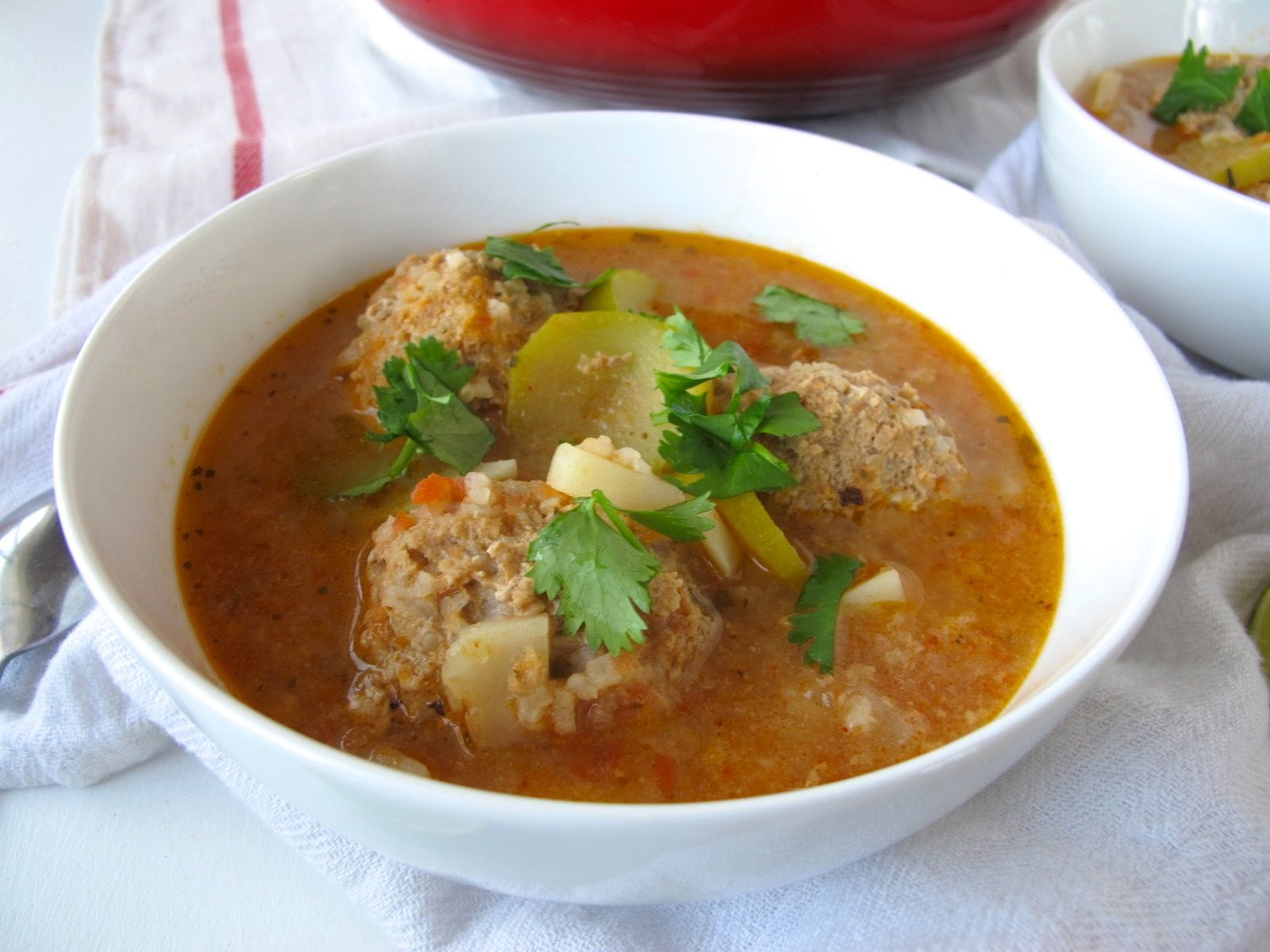Calling all foodies! Get ready for a taste-bud adventure as we dive into the amazing history of albondigas soup, a dish that’s been making people’s mouths water for centuries. We’ll take you back in time to discover where it all started, what makes it so special, and why it’s still one of the most beloved dishes today. So buckle up and prepare your senses for a culinary expedition that will leave you yearning for more!
History of Albondigas Soup
Ever dipped a spoon into a steaming bowl of albondigas soup? It’s more than just a delicious meal; it’s a culinary journey through time! This comforting dish, with its tender meatballs and flavorful broth, has a history as rich and savory as the soup itself.
Our story likely begins way back in medieval Spain. Imagine bustling markets filled with the aroma of spices and the chatter of vendors. That’s where we first encounter these tasty meatballs. The word “albondigas” itself comes from the Arabic “al-bunduq,” meaning “small round object,” which perfectly describes these little bites of flavor.
Fast forward a few centuries, and Spanish explorers set sail for new lands, bringing their culinary traditions with them. When they arrived in Mexico, albondigas found a new home and a brand new personality. Mexicans embraced the dish, transforming it into what we know and love today: sopa de albondigas. This hearty soup, simmered with aromatic vegetables and often spiced with regional chilies, quickly became a beloved staple in Mexican cuisine.
But the story doesn’t end there. As with any beloved dish passed down through generations, variations began to pop up across Mexico. Each region added its unique flair, showcasing the incredible diversity of Mexican cooking. In central Mexico, you might find albondigas soup simmered with earthy chipotle peppers, while the coastal regions might feature a brighter, tangier broth with a squeeze of lime.
Think of albondigas soup as a blank canvas—every cook gets to add their own strokes of creativity. It’s a testament to how food can evolve and adapt, reflecting the history and culture of the people who prepare it.
More Than Just a Meal
In Mexico, albondigas soup isn’t just about satisfying hunger; it’s about creating connections. This soul-warming dish often takes center stage at family gatherings and festive occasions, symbolizing warmth, nourishment, and togetherness. It’s a culinary bridge between generations, with each spoonful carrying the flavors of tradition and family history.
A Healthy Dose of History
Beyond its delicious taste and cultural significance, albondigas soup also packs a nutritional punch! The meatballs, often made with a combination of ground meat, rice, and spices, provide a healthy dose of protein. The broth, simmered with a medley of vegetables, is rich in vitamins and minerals. It’s a meal that nourishes both body and soul!
The beauty of albondigas soup lies in its adaptability and its ability to transcend borders and generations. It’s a reminder that a simple bowl of soup can hold centuries of history, cultural fusion, and a whole lot of love. So, the next time you enjoy a steaming bowl of albondigas, take a moment to savor the flavors and appreciate the incredible journey this dish has taken through time.
Where Did Albondigas Originate?
We’ve been talking about albondigas, those little balls of deliciousness that make a meal feel complete. But have you ever wondered where they came from? Their journey takes us back centuries and across continents, with twists and turns more exciting than a plate of spaghetti and meatballs!
We can probably trace the origins of these tasty morsels back to the Middle East, sometime around the 8th century. Back then, they were called “al-bunduqa,” – a name quite similar to the “albondigas” we know and love. Experts believe that Persian cuisine played a significant role in their development. The Persians were known for their love of meatballs, using them in all sorts of dishes. So, it makes sense that the albondigas story starts somewhere in that neighborhood.
Fast forward to the 8th century again, but this time, we’re in Spain. The Moorish conquerors, who, like most, had a thing for good food, brought albondigas with them when they arrived. And those meatballs were a hit! They were so popular that “albondigas” became a Spanish word, and the meatballs themselves became a regular on Spanish dinner tables.
But the journey doesn’t stop there! When the Spanish decided to explore the New World, they brought their trusty albondigas along for the ride. That’s how these little balls of flavor ended up in Mexico. And Mexico totally embraced them. Albondigas found their perfect match in sopa de albondigas, a heart-warming soup that’s been passed down through generations of Mexican families.
The beauty of albondigas is that they’re like chameleons. As they traveled, they picked up local flavors and ingredients, creating a whole family of albondigas variations. In Mexico, they’re often made with ground beef, seasoned with vibrant spices, and simmered in a rich tomato-based broth. But hop over to Spain, and you might find them made with a mix of beef and pork, seasoned with paprika and saffron, and swimming in a lighter broth. It just goes to show, there’s an albondiga out there for everyone!
No matter how you prepare them, the heart of an albondiga remains the same: tender, flavorful meat, lovingly shaped into a ball, and often served in a comforting broth. It’s a dish that transcends borders and cultures, bringing people together one delicious bite at a time.
And the story of albondigas isn’t over yet! Who knows what delicious twists and turns await these little culinary travelers in the future?
Where Did Meatball Soup Originate?
We’re talking about meatball soup, right? Not just any meatball soup, but the kind that makes your tummy rumble with anticipation – albondigas soup! It’s like a warm hug in a bowl, and it’s been satisfying folks for ages. But where did this deliciousness even come from?
Well, imagine traveling back in time, way back to when the Berbers and Arabs were spicing things up in the culinary world. It’s thought that these were the folks who first started rolling little balls of meat and cooking them up in delicious ways – the earliest versions of our beloved meatballs. And guess what? These tasty morsels hopped on a boat with Spanish explorers in the 1500s and sailed all the way to Mexico.
Now, remember that part of Spain called Al-Andalus? That place was like a culinary melting pot back in the day, with the Moors introducing all sorts of amazing spices, flavors, and cooking tricks to the region. This fusion of cultures is where we think albondigas really started to take shape, borrowing flavors and traditions from both sides. It’s like a tasty history lesson in every spoonful!
Over time, Mexico embraced albondigas as their own, and can you blame them? This soup became a beloved classic in Mexican cuisine, a dish simmering on stoves and warming hearts in homes all over the country. In Mexico, the aroma of albondigas probably brings back memories of family dinners and celebrations – it’s true comfort food at its finest.
But here’s the thing about food history: it’s not always a straight line from point A to point B. There are always different theories and ideas floating around, and who knows, maybe we’ll discover even more about the origins of albondigas as researchers dig deeper. One thing’s for sure, though: this soup has a rich and flavorful past, and it’s a delicious example of how food can bring cultures together. So, next time you enjoy a bowl of albondigas, take a moment to appreciate its incredible journey through time!
What Is a Fun Fact About Albondigas?
We’ve been talking about albondigas, these tasty little meatballs that are a staple in so many cuisines. But here’s something that might surprise you: the word “albondigas” itself has a pretty interesting backstory. It actually comes from the Arabic word “al-bunduq,” which means “hazelnut.” Pretty cool, right?
Now, you might be thinking, “Hazelnuts? What do hazelnuts have to do with meatballs?” Well, it’s not about the ingredients. It’s all about the shape! Those early albondigas were probably closer in size to hazelnuts than the meatballs we’re used to seeing today. This little linguistic tidbit suggests that the history of albondigas likely goes way back, with roots in Moorish cuisine before making its way to Spain.
Key Takeaways:
- The word “albondigas” is derived from the Arabic word for “hazelnut,” hinting at their possible origins and smaller size in the past.
- Albondigas have a rich history, likely originating in the Middle East before becoming a popular dish in Spain and beyond.
Why Is My Albondiga Soup So Greasy?
So, you’ve whipped up a big pot of albondiga soup, but something’s not quite right – it looks like an oil slick on top! Don’t worry, we’ve all been there. That layer of grease floating on top is a common issue, but luckily, there are some easy fixes to make your soup less greasy and more enjoyable.
Often, the culprit behind a greasy albondiga soup is the ground meat itself. When you brown ground beef, pork, or a combination of the two, it releases fat as it cooks. This is totally normal, but too much fat can overpower the other delicious flavors in your soup.
Here are a few things you can do to tackle the grease:
- Start with Leaner Meat: Opting for leaner ground meat can make a big difference. Ground chuck or even ground turkey are great alternatives to fattier ground beef. They’ll still provide that hearty flavor without adding as much grease to your soup.
- Drain the Fat: After browning your ground meat for the albondigas (meatballs), tilt the pan and use a spoon to carefully scoop out any excess fat that has accumulated in the pan. You can even pour the meat into a strainer lined with paper towels for a few minutes to absorb any lingering grease.
- The Bread Trick: Believe it or not, a simple slice of bread can work wonders in absorbing excess grease. Just drop a slice of bread into your simmering soup for about 10 minutes. The bread acts like a sponge, soaking up excess fat. Just remember to remove the bread before serving!
- Skim It Off: Once your soup has cooled slightly, the fat will solidify on top, making it even easier to remove. Use a spoon to skim off the congealed fat from the surface. For a more thorough approach, you can chill the soup completely – the fat will solidify and you can easily lift it off.
- Add Veggies Power: Certain vegetables, like carrots, celery, and onions, can help absorb some of the excess fat as they simmer in the soup. So don’t be shy with those veggies!
A Few More Things to Keep in Mind
- Cooking Time: Simmering your soup for a longer period can help the fat rise to the surface, making it easier to skim off.
- Fat Content Varies: Remember that the fat content of ground meat can vary depending on the cut and how it’s processed, so even if you choose a leaner option, it’s always a good idea to keep an eye on the grease level.
By taking these simple steps, you can significantly reduce the greasiness of your albondiga soup and enjoy a tastier and healthier meal. Happy cooking!
Why Are My Albondigas Pink Inside?
So, you’re making a big batch of albondigas – those yummy Spanish meatballs – and you cut one open, only to be greeted by a slightly alarming pink center. Don’t freak out just yet! There are a few reasons why your albondigas might be rocking that rosy hue, and it doesn’t always mean a one-way ticket to Food Poisoning City.
Let’s break it down:
- Undercooked: The most likely culprit is that they are simply not cooked all the way through. Just like with any meat, the inside needs to reach a certain temperature to be safe to eat. If the heat hasn’t had enough time to work its magic, the center can stay pink, even if the outside looks brown and ready to go.
- Myoglobin: Ever heard of myoglobin? It’s this protein in meat that gives it that reddish color. When you cook meat, the myoglobin goes through some changes, turning from red to brown as the meat cooks. But, if the cooking gets interrupted or the heat’s too low, the myoglobin might not fully transform, leaving you with—you guessed it – a pinkish tinge.
- Meat Type: Hold up! Before you toss the whole batch, what kind of meat did you use? Sometimes, the pinkness can just be the natural color of the meat itself, especially if you’re working with ground poultry or game meats. They tend to have a paler hue to begin with, so even when cooked through, they might not have that classic browned look.
- Seasonings: One last thing to consider: Your spice rack! Believe it or not, certain seasonings and additives can actually give your albondigas a pinkish tint. Paprika, for example, is known for its vibrant red color, and sodium nitrite, which is often found in cured meats, can also lend a pinkish hue.
Okay, so how do you make sure your albondigas are safe and delicious?
- Temperature is key! A meat thermometer is your best friend in the kitchen. For ground beef, aim for an internal temperature of 165°F (74°C). For ground poultry, 160°F (71°C) is the magic number.
- Don’t overcrowd the pan. Give those albondigas some breathing room! If they’re packed in too tightly, the heat won’t circulate properly, leading to uneven cooking.
- Low and slow is the way to go. Simmering your albondigas in sauce allows them to cook gently and evenly, ensuring that the inside gets up to a safe temperature without burning the outside.
Bottom line: A little pink in your albondigas isn’t always cause for alarm, but it’s always better to be safe than sorry. Check that internal temperature, and if in doubt, give them a little more time on the heat. Happy cooking!
What Ethnicity Is Meatballs?
Picking an ethnicity for meatballs is like trying to pick a favorite spice in a delicious curry – there are just too many blended together to choose! We can trace those little balls of flavor back through history, watching them change and adapt as they travel across the globe.
Think of ancient Rome, where they were already a thing! Back then, herbs and breadcrumbs were the seasonings of choice, a far cry from the diverse flavors we see today. Then, along came the Moors in the 8th century, bringing their own culinary traditions to the Iberian Peninsula. That’s where the story gets really interesting because their influence is what helped shape what we now call “albondigas.”
The name itself is a clue. “Albondigas” actually comes from the Arabic word “al-bunduq,” which means “hazelnut.” It makes sense when you think about it—those little meatballs do resemble hazelnuts!
From Spain, albondigas hopped over to Latin America, and that’s where things really took off. Each culture took this basic idea and made it their own. Imagine comforting bowls of Mexican “sopa de albondigas” (meatball soup) warming families on chilly evenings, or the Filipino twist of “albóndigas sa miswa” – meatballs nestled in a bed of noodles.
But the story doesn’t stop there! Think of Spain, where a plate of albondigas, bathed in a rich, savory sauce, often takes center stage as the main course. Then hop over to Italy, where “polpette” are the star in dishes like “spaghetti e polpette” (spaghetti and meatballs). And, of course, who can forget the classic American meatball? Whether piled high on a crusty roll or simmering in a pot of marinara, they’re pure comfort food.
So, asking “What ethnicity is meatballs?” is almost impossible to answer. It’s more like they’ve become a citizen of the world! A testament to the power of food to bring cultures together, one delicious bite at a time.
Who Originally Made Meatballs?
So, we were talking about meatballs, right? It’s actually kind of a mystery wrapped in a delicious, savory puzzle. We know the Moors brought a dish that looked a lot like meatballs to the Iberian Peninsula back in the 8th century. And it seems like that really kicked off the whole albondigas craze we see today, especially in Latin America. Think of it like a culinary chain reaction!
Now, albondigas are basically the rockstars of comfort food in places like Mexico. Picture this: a rich, flavorful broth simmering away with ground meat, veggies, and these tender little meatballs just begging to be devoured. But here’s the cool part – albondigas soup is like a blank canvas. You can add whatever you like! Spicy peppers, different herbs, maybe even a squeeze of lime – it’s all about making it your own.
But the story doesn’t end there. While the Moors might have sparked the albondigas fire, the truth about meatballs probably goes way further back. I mean, people have been cooking meat for ages, so it’s totally possible that meatballs popped up in different parts of the world, totally independent of each other. It’s like that old saying, “great minds think alike” – or in this case, “great cooks!”
So, the next time you’re enjoying a bowl of albondigas, take a second to ponder the long and delicious journey those meatballs have taken. From ancient kitchens to modern tables, it’s a culinary adventure that spans cultures and centuries!
Where Did Lion’s Head Meatball Originate?
Curious about the Lion’s Head meatball, huh? This culinary gem has been making mouths water for generations, but pinning down its exact origin is a bit like solving a delicious mystery.
While we don’t have a definitive answer (yet!), there’s a fascinating link to a Spanish soup called albondigas that might hold some clues. “Albondigas” basically translates to “small round things” in Spanish – pretty straightforward, right? – and refers to those tasty little meatballs simmered in broth. We find these popping up way back in medieval Spain, likely picking up some influences from Arab cooking styles along the way.
Now, picture this: Spanish explorers setting sail across the globe, bringing their beloved albondigas recipe along for the ride. When they reached Mexico, this Spanish staple got a flavor upgrade, embracing the vibrant spices and ingredients of the region. This culinary fusion gave us the Mexican albondigas soup we know and love today.
But let’s circle back to our Lion’s Head meatball. This Chinese delicacy shares some striking similarities with its Spanish counterpart. Both typically feature ground pork, a symphony of aromatic spices, and that comforting broth.
Could this be a coincidence? Maybe, but some culinary sleuths believe it hints at a deeper connection. It’s possible that both dishes have roots in ancient meatball-making traditions, passed down through generations and across continents.
Here’s the thing about food history – it’s a bit like piecing together a giant, delicious puzzle. Sometimes the pieces fit perfectly, and sometimes we’re left with tantalizing clues and a whole lot of questions. Who knows what other culinary connections are waiting to be uncovered?
In a nutshell:
- Albondigas, those little Spanish meatballs, have a long history dating back to medieval Spain, likely borrowing some inspiration from Arab cuisine.
- Thanks to those adventurous Spanish explorers, albondigas made their way to Mexico, where they evolved into the iconic Mexican albondigas soup.
- The Lion’s Head meatball, a star of Chinese cuisine, shares some intriguing similarities with albondigas. This might suggest a shared culinary ancestry rooted in ancient meatball traditions.
Where Did Pasta and Meatballs Originate?
You might be surprised to learn that this beloved dish of pasta and meatballs didn’t originate in Italy! Shocking, right? While Italians are undoubtedly masters of pasta, the classic spaghetti and meatballs we know and love has a bit of a murky past.
Here’s the thing: meatballs themselves have been around for ages, popping up in various forms across different cultures. Think about it – ground meat, seasoned and rolled into a ball? It’s a simple, ingenious concept that likely emerged independently in different parts of the world.
For instance, there’s evidence suggesting that ancient Romans enjoyed a dish resembling meatballs called “isicia omentata.” These were essentially meatballs wrapped in a membrane from the animal’s stomach, then grilled or roasted. Fast forward to the Middle Ages, and you’ll find meatballs popping up in Persian, Arab, and even Chinese cuisine. See, meatballs are a global sensation!
So how did they end up paired with pasta? Well, it probably started with Italian immigrants arriving in America in the late 19th and early 20th centuries. They brought their love of pasta and their knowledge of meatballs, and America, with its abundance of ingredients, provided the perfect playground for culinary fusion.
Imagine this: Italian immigrants, often working with limited resources, discover readily available ground meat in their new home. They combine it with their culinary traditions, creating larger, more substantial meatballs. Meanwhile, pasta, which was once a delicacy, becomes increasingly affordable in America. What happens when you have these two delicious things readily available? Boom! Spaghetti and meatballs are born!
Now, it’s important to note that this is a likely scenario, but culinary history is a bit like a delicious stew – it’s got layers, influences, and a whole lot of simmering over time. There’s no single definitive answer to who exactly decided to pair pasta and meatballs, but the story of Italian immigration to America offers a compelling explanation for how this dish became so iconic.
So next time you’re enjoying a plate of spaghetti and meatballs, remember the journey these humble ingredients have taken. It’s a testament to the power of culinary innovation and the delicious results that happen when different cultures collide.
Did Meatballs Originate in Sweden?
So, we’ve been talking about meatballs, those little balls of deliciousness that are a staple in cuisines around the world. But did they actually start in Sweden? Well, the truth is, it’s a bit of a mystery.
Think of it like this: meatballs are like an ancient recipe passed down through generations. Evidence suggests they’ve been around for ages, popping up in different cultures throughout history. It’s very likely people started making meatballs as a clever way to use up leftovers, mixing scraps of meat with bread or other ingredients to make something tasty and filling. Over time, these humble beginnings transformed into the beloved dish we know today.
Now, back to Sweden. While their version, the famous Köttbullar, is super popular, pinning down their exact origin is tricky. Some folks believe the story goes that King Charles XII brought them back from Turkey in the 1700s. Others think the recipe might have traveled along the Silk Road, suggesting a Persian connection.
The mystery is part of what makes meatballs so fascinating! What we do know is that Sweden has definitely made its mark on meatball history. Their version, with its special blend of beef and pork, seasoned with nutmeg and allspice, is truly iconic. And when those flavorful meatballs are paired with creamy gravy, tangy lingonberry jam, and a side of mashed potatoes? Forget about it! It’s pure comfort food heaven.
But don’t think for a second that Sweden has a monopoly on meatballs. Oh no, this is a dish embraced by countless cultures, each adding its own unique spin. Take Italy, for example. Their polpette often feature a mix of beef, pork, or veal, while in Spain, you’ll find albondigas simmering in flavorful tomato sauce. And then there’s kofta, a Middle Eastern favorite, made with lamb or beef and a symphony of spices like cumin, coriander, and paprika.
The point is, from bustling street markets in Bangkok to cozy family kitchens in Mexico City, meatballs are a global sensation. Whether they’re served as a main course, a tasty appetizer, or tucked into a comforting sandwich, one thing’s for sure: meatballs have definitely earned their place as a beloved food enjoyed by people all over the world. So, while the exact birthplace of the meatball might forever remain a delicious mystery, we can all agree that their enduring appeal is a testament to the power of simple, flavorful food to bring people together.
Don’t forget to check out the history of other iconic items, like:
- Discover the captivating history of Akubra hats, which embodies the rugged spirit of the Australian outback.
- Delve into the world of Annalee dolls, handcrafted with love and reflecting the timeless charm of childhood memories.
- Embark on a journey through the history of Apalachicola, Florida, a coastal town where time seems to stand still, preserving its rich heritage and maritime traditions.















